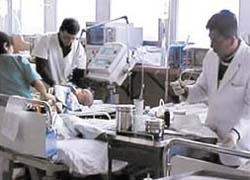The ICU: caring for patients' relatives
An intensive care unit (ICU) is a ward staffed by medical support who have been specially trained in the high levels of care required by each pathological state.

In the ICU, critically ill patients, who could not be safely cared for in general wards, are under constant control, day and night, and everything is done to ensure they receive the highest level of care possible.
Commonly admitted through the accident and emergency (A&E) departments, or from the operating rooms after major surgery, these patients often require life-sustaining treatments, such as artificial ventilation, dialysis and cardiac resuscitation.
Provision of intensive care
According to Bennett & Bion, intensive care comprises 1-2% of total bed numbers in the UK, which compares with proportions as high as 20% in the USA. Therefore, patients admitted in Britain tend to be more severely ill than those in America. The average ICU in Britain has four to six beds, although units in larger hospitals, especially those receiving tertiary referrals, are bigger. Few units have more than 15 beds.
Caring for patients’ relatives
An important role of the ICUs is to assist families of patients during their stay in the ICU. As Bennett & Bion point out, the intensive care environment can be extremely distressing for both conscious patients and their relatives. The high mortality and morbidity of patients requires considerable psychological and emotional support, which is provided by the medical and nursing staff often in conjunction with chaplains and professional and lay counsellors. Such support is difficult and time consuming and requires the involvement of senior staff. Many relatives and friends wish to be close to critically ill patients at all times. Visiting periods are usually flexible and many units have a dedicated visitors’ sitting room with basic amenities such as a kitchenette, television and toilet facilities. Often on-site overnight accommodation can be provided.
Witnessed resuscitation
Witnessed resuscitation is widely accepted in paediatric practice and is becoming more common in adult emergency departments. Grice, Picton and Deakin, at the Southampton University Hospitals, published a research study examining attitudes of staff, patients and relatives to witnessed resuscitation in adult ICUs. Results showed that if relatives requested to be present, 70% of doctors and 82% of nurses would allow it - if relatives were escorted. The role of the escort was felt to explain, prevent interference, and provide emotional support; 29% of patients and 47% of relatives wanted to be together during resuscitation, the commonest reason being to provide support and see that everything was done.
Life-sustaining treatment decisions
Cardoso et al. evaluated Portuguese intensive care physicians in terms of ‘do-not-resuscitate’ decisions to withhold/withdraw treatment. The investigators found that, in most of the responding cases, those decisions are made only by the medical group, with little input from the nurses (15%), patients (9%) or patients’ relatives (11%), although most of respondents expressed a wish to involve them more in the process. Sex, and religious beliefs of the respondents influences the way in which these decisions are made.
Abuse and violence towards staff
A postal survey of senior nurses in ICUs in England and Wales, conducted by Lynch, Appelboanes and McQuillan (Queen Alexandra Hospital, 2003), aimed to ascertain the frequency of abusive and violent behaviour by patients and relatives towards intensive care staff. During the study period, verbal abuse of nurses, either by patients or relatives, occurred in 74% of ICUs; and as much as in 77% of ICUs nurses experienced physical abuse either by patients or relatives. Illness was the main perceived cause of offences by patients, whilst ‘distress’ (45%), alcohol (24%) and sociopathic behaviour (27%) were the main causes amongst relatives.
When the patient dies
Malacrida et al. (Lugano, Switzerland) studied the reasons for eventual dissatisfaction among families of patients who died in the ICU, in terms of the assistance offered during the patient’s stay in the hospital and the information received from the medical staff. This survey found that the relatives of patients who died were most dissatisfied with the care received according to a) the type of death; this is sudden death vs. death preceded by a gradual deterioration in the patient’s status, and b) the manner in which the relatives were notified of the death (in person vs. by telephone). The authors stressed the need for improvement, especially in communicating information to the relatives of these patients.
Conclusion: Communication skills and organisational procedures become key issues for an excellent ICUs’ functioning.
01.03.2005






